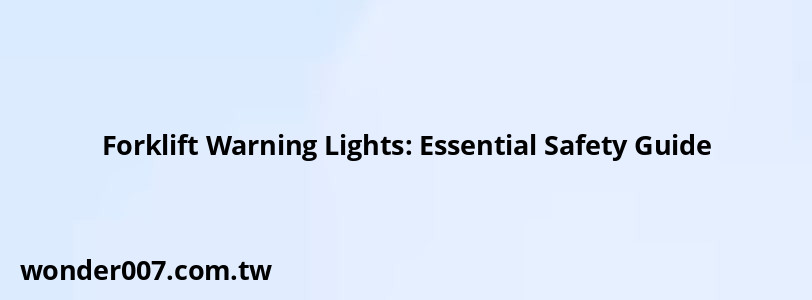Forklift Warning Lights: Essential Safety Guide

Forklift Warning Lights
Forklift warning lights are crucial safety features that alert operators and nearby workers to potential hazards or issues with the vehicle. Understanding these lights is essential for maintaining a safe work environment and preventing accidents. Let's explore the meanings of common forklift warning lights.
Battery Warning Light
The battery warning light typically appears as a battery icon on the dashboard. When illuminated, it indicates either a low battery charge or an issue with the charging system. Operators should immediately check the battery connections and charge or replace the battery if necessary.
Engine Oil Pressure Light
Represented by an oil canister symbol, the engine oil pressure light signifies dangerously low oil pressure. If this light remains on after starting the forklift, operators must stop the engine immediately and check the oil level. Continuing to operate with low oil pressure can cause severe engine damage.
Temperature Warning Light
The temperature warning light, often depicted as a thermometer in liquid, indicates engine overheating. When this light comes on, operators should turn off the engine, allow it to cool, and check the coolant level. Overheating can lead to significant engine damage if not addressed promptly.
Hydraulic Oil Warning Light
Shown as an oil can with a wavy line beneath, the hydraulic oil warning light alerts operators to low hydraulic fluid levels or system issues. This warning is critical as it can affect the forklift's lifting capabilities and overall functionality.
Brake Warning Light
The brake warning light, usually an exclamation mark inside a circle, indicates a problem with the braking system. This could be due to low brake fluid, worn brake pads, or a system malfunction. Addressing brake issues immediately is crucial for operator safety.
Tilt Warning Light
Depicted as a forklift mast with an angle indication, the tilt warning light warns operators when the mast tilt angle exceeds safe limits. Operators must adjust the load or mast position to prevent tipping accidents.
Seatbelt Warning Light
The seatbelt warning light, shown as a seated person with a belt across their lap, reminds operators to buckle up before operating the forklift. This simple safety measure can prevent serious injuries in case of accidents.
Air Filter Warning Light
Represented by a fan or filter-like icon, the air filter warning light indicates a clogged or dirty air filter. Replacing or cleaning the air filter ensures optimal engine performance and longevity.
Check Engine Light
The check engine light, often an engine block icon or the words "Check Engine," indicates a general malfunction within the engine management system. Professional diagnostic tools are typically required to identify the specific issue.
Importance of Heeding Warning Lights
Paying attention to forklift warning lights is crucial for several reasons:
- Preventing accidents: Many warning lights indicate issues that could lead to accidents if ignored.
- Maintaining equipment: Addressing issues early can prevent more serious and costly repairs.
- Ensuring efficiency: A well-maintained forklift operates more efficiently, improving productivity.
- Compliance: Properly responding to warning lights helps maintain compliance with safety regulations.
Operators should be trained to recognize and respond appropriately to all warning lights. Regular maintenance checks and prompt attention to warning indicators can significantly reduce the risk of accidents and equipment failure.
FAQs About Forklift Warning Lights
- What should I do if multiple warning lights come on at once?
Stop the forklift immediately in a safe location, turn off the engine, and contact your supervisor or maintenance team for assistance. - How often should forklift warning lights be tested?
Warning lights should be checked as part of daily pre-operation inspections to ensure they are functioning correctly. - Can I continue operating if the check engine light is on?
It's best to have the forklift inspected by a qualified technician before continuing operation, as the issue could be serious.
Related Posts
-
Start Stop Service Required: Troubleshooting Guide for Volvo XC90
29-01-2025 • 285 views -
Ford Focus Freeze Plug Location and Replacement Guide
30-01-2025 • 195 views -
Brake Booster: Essential Guide for 2008 Ford Edge
29-01-2025 • 195 views -
Jeep Grand Cherokee Key Fob Programming Guide
29-01-2025 • 237 views -
Nissan Titan 2005: Fuse Diagram and Locations Guide
29-01-2025 • 139 views
Latest Posts
-
Are O2 Sensors Covered Under Warranty
01-02-2025 • 376 views -
Rear Brake Caliper Piston Won't Compress
01-02-2025 • 356 views -
How To Turn Off Paddle Shifters Mercedes
01-02-2025 • 377 views -
2015 Chevy Traverse AC Recharge Port Location
01-02-2025 • 409 views -
Power Steering Fluid Leak On Passenger Side
01-02-2025 • 457 views
Popular Posts
-
V12 Engine Costs: What You Need to Know
26-01-2025 • 679 views -
Power Steering and ABS Light On: Causes and Solutions
27-01-2025 • 643 views -
Hino Warning Lights: Understanding Dashboard Alerts
26-01-2025 • 765 views -
EPC Warning Light: What It Means for Your Vehicle
27-01-2025 • 630 views -
EPC Light: Understanding Causes and Solutions
26-01-2025 • 1053 views
